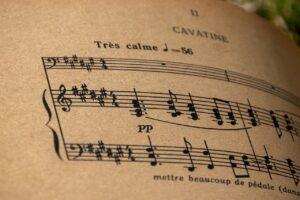Estimated reading time 4 minutes
Table of Contents
Introduction
Have you ever wondered why just intonation sounds different in different keys? This happens because the structure of just intonation diverges from equal temperament (the modern tuning standard), resulting in a different sound. Read more to learn the answer to the question, “Why do just intonation keys have different aural characteristics?”
This article uses musical terms. For definitions, see the Glossary at the end of the post.

Why Just Intonation Keys Have Different Aural Characteristics: Just Intonation vs Equal Temperament
- “Why do just intonation keys have different aural characteristics?” It has to do with just intonation’s tuning structure. To understand this better, we’ll look at how just intonation (JI) differs from equal temperament (ET).
- The semitones between the 12 ET tones divide the octave (Thus, why it’s called equal temperament.) So, the tuning will sound the same in all keys. However, the JI intervals have been tuned to the harmonic series. This means that an interval class in JI, such as a semitone, can have more than one interval size.
- In other words, a half step in one key may be larger or smaller than in other keys. Which will be true for other intervals such as thirds, fifths, and octaves as well. For instance, the distance between E and Eb may not be the same as the distance between D and Db.
- In addition, the overall quality of JI will sound different than ET because the harmonies will be more in tune. However, the melodies in JI can sound “stretched” when compared to ET.
- A third difference between JI and ET (and the point of today’s post) concerns key coloration. Because of the equal nature of ET, you don’t get any key coloration between keys.
- However, in JI, depending on the intervals chosen by the composer, the keys can sound different from each other, because of key coloration. This directly stems from the fact that JI can have more than one size interval per interval class.

Key Coloration and Why Just Intonation Keys Have Different Aural Characteristics
- “Why do just intonation keys have different aural characteristics?” Because some JI keys may have a different tuning in one key versus another.
- It really depends on how many pitches the composer decides to use. If the composer has an infinite number of notes (such as when using a soft-synth program), there won’t necessarily be any key coloration.
- Why? Because the composer will always have the option to choose the ideal interval combinations to create sweet sounding chords.
- However, if a composer wants to use physical instruments, ideal interval combinations won’t always be an option. For example, Harry Partch’s tuning system (with its array of custom-built instruments), has only 43 notes.
- Why is this important? Because if you compose near the edges of Partch’s tuning system, you’ll sometimes need to choose less than ideal interval combinations to create your chords.
- When this happens, it impacts the overall tone color of the chord. If enough chords have this happen, you may notice a difference in the sound quality between the keys.
- Also, some composers may choose different interval combinations from one key to another because they like the sound.
- The first video below shows a Chopin piece performed in an idealized just intonation tuning using the computer programs Sibelius and NotePerformer.
- The second video shows how you’d make some of Partch’s instruments. In addition, it has his music playing in the background. You can hear he’s made note selections that you won’t find in ET compositions. Some pieces sound almost like they could be from an ET composition while others don’t.
Mobile users: for best results watching the videos, tilt your screen 90o to the right.
Video: A Chopin Piece in an Idealized Just Intonation Tuning
Video: Harry Partch’s Instruments and Music
Concluding Thoughts to “Why do just intonation keys have different aural characteristics?”
“Why do just intonation keys have different aural characteristics?” Because JI has a wider range of options for tuning intervals from one key to the next. Therefore, key coloration can result from either the composer’s choice of intervals or from compositional necessity. Have fun listening and composing!
Related Content
- Is Just Intonation Impractical?
- Intonation and Supplemented Equal Temperament
- Choosing the Right Sound to Play with Just Intonation
- What’s the Difference Between Just Intonation and Equal Temperament?
© 2023 Geoffrey Keith
Join me for in-person or online lessons today!
Glossary
Anyone Can Learn to Sing, Including You
Anyone can learn to sing, including you. An old Zimbabwe proverb says, “If you can walk, you can dance. If you can talk, you can sing.” So, if you can talk, why don’t you give singing a try? Read more to find out how it works. Estimated reading time 3 minutes.
Read MoreSinging Shape Notes Solfege Ionian Melodies
Want to be able to sing modes? I can help. You’ll see the Ionian mode more often than any other type of mode. It’s used extensively in pop, jazz, classical, and even folk music. In “Singing Shape Notes Solfege Ionian Melodies,” you’ll be singing the last mode we’ll look at in the modes series. Keep reading to learn more. Estimated reading time 2 minutes.
Read MoreWhat Purpose Do Accidentals Serve in Reading Sheet Music?
“What purpose do accidentals serve in reading sheet music?” Sharps, flats, and naturals (collectively called accidentals) grew out of a problem that needed to be fixed in the mediaeval music notation. The music theorists of the time slapped their fix onto the preexisting notation system, and that fix is still with us to this day. However, having confused generations of budding musicians, the results of the fix leave a lot to be desired. Click to answer the question, “What purpose do accidentals serve in reading sheet music?” Estimated reading time 3 minutes.
Read MoreWhat Does the Exotic Sounding Word Bravo Mean at a Concert?
Do you wonder what the word bravo means? You can sometimes hear it shouted at classical music concerts. Keep reading “What Does the Exotic Sounding Word Bravo Mean at a Concert?” to learn classical concert etiquette. Estimated reading time 2 minutes.
Read More




